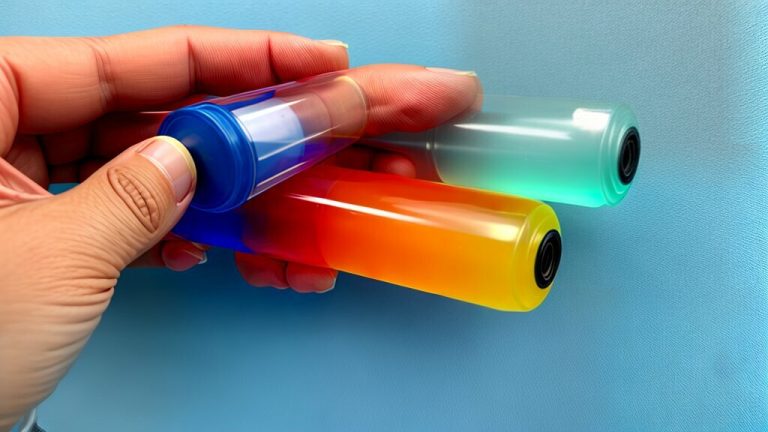How to Calculate Serum Osmolality: A Friendly Guide for Easy Steps
Have you ever wondered how to calculate serum osmolality? Serum osmolality is an essential medical parameter which measures the concentration of the particles present in the blood. It is crucial in diagnosing certain conditions and monitoring patient treatment. This section will provide a step-by-step guide on calculating serum osmolality. We will explain the osmolality formula and provide the necessary equation for serum osmolality calculation. By the end of this section, you will clearly understand the process and be able to perform accurate serum osmolality calculations.
Key Takeaways:
- Serum osmolality measures the concentration of particles inthe the blood.
- Calculating serum osmolality is essential for patient care.
- Understanding the osmolality formula is crucial for accurate serum osmolality calculation.
- The step-by-step process of serum osmolality calculation will be provided in this section.
Understanding Serum Osmolality
Before diving into the delicate process of calculating serum osmolality, it’s essential to understand the concept and why it’s crucial in the medical field. Serum osmolality refers to the concentration of solutes (particles) in a serum sample. It directly correlates with the serum’s ability to attract and retain water, which affects the body’s fluid balance. A change in serum osmolality can signal an underlying medical condition, such as dehydration, renal disease, or alcohol intoxication.
Serum osmolality values are expressed in millimoles per kilogram of water (mmol/kg) and are derived using the osmolarity formula. Osmolarity is the number of particles in a solution, including ions, proteins, and other organic molecules. The osmolarity formula calculates the number of osmoles (particles) of solute per liter of solution.
Components of Serum Osmolality Calculation
Before starting the osmolality calculation process, several components must be considered. These components include:
- Sodium (Na+) – measured in millimoles per liter (mmol/L)
- Glucose – measured in milligrams per deciliter (mg/dL)
- Blood Urea Nitrogen (BUN) – measured in milligrams per deciliter (mg/dL)
- Other solutes – such as ethanol and methanol, which can affect serum osmolality
It is important to note that all values should be obtained from the same blood sample to ensure accuracy.
The following steps outline the process of gathering the necessary measurements:
- Obtain the serum sodium (Na+) level from a blood sample. This is typically measured using a blood test known as a basic metabolic panel (BMP).
- Using the BMP test, measure the serum glucose and BUN levels from the same blood sample.
- If applicable, obtain any other solute measurements from the same blood sample.
Once you have gathered the necessary measurements, you can proceed with the osmolality calculation process.
Osmolality Formula and Equation
The osmolality formula is used to calculate the concentration of the osmotically active particles in a solution, while the specific equation for calculating serum osmolality is:
Serum Osmolality (mOsm/kg) = 2(Na) + glucose/18 + BUN/2.8
In this equation, the values for sodium (Na), blood urea nitrogen (BUN) and glucose are measured in millimoles per liter (mmol/L), milligrams per deciliter (mg/dL), and millimoles per liter (mmol/L), respectively.
It is important to note that the osmolality equation assumes that the concentrations of other osmotically active particles (such as potassium and chloride ions) are negligible compared to the measured values.
Breaking Down the Equation
Let’s take a closer look at each component of the serum osmolality equation:
| Component | Explanation |
|---|---|
| Na | Sodium, the most abundant cation in the extracellular fluid, plays a significant role in serum osmolality. It is multiplied by 2 in the formula because sodium ions typically carry a positive charge. |
| Glucose | Glucose is an ordinary osmotically active particle in the blood and is measured in milligrams per deciliter (mg/dL). It is divided by 18 in the formula because glucose molecules contain six carbon atoms, 12 hydrogen atoms, and six oxygen atoms. The molecular weight of glucose is therefore 6(12) + 12(1) + 6(16) = 180 grams per mole (g/mol). One mole of glucose contains 180 grams, equivalent to 180,000 milligrams. Dividing the measured glucose value (in mg/dL) by 18 converts it to millimoles per liter (mmol/L). |
| BUN | Blood urea nitrogen (BUN) measures the amount of nitrogen in the blood which comes from urea, a waste product of protein metabolism, usually measured in milligrams per deciliter (mg/dL) and is divided by 2.8 in the formula because urea contains two nitrogen atoms and a molecular weight of 60 g/mol. One mole of urea contains 2 moles of nitrogen, equivalent to 28 grams. Dividing the measured BUN value (in mg/dL) by 2.8 converts it to millimoles per liter (mmol/L). |
By adding the values for each component in the serum osmolality equation and multiplying the sum by 2, we can obtain the serum osmolality measurement in milliosmoles per kilogram (mOsm/kg).
Gathering Data for Serum Osmolality Calculation
Before performing the serum osmolality calculation, it is essential to gather the necessary data. The equation requires measuring specific components, including sodium, glucose, and blood urea nitrogen (BUN).
Sodium levels can be measured using a blood test, while glucose can be obtained through blood or urine tests. BUN levels can be determined through a blood test, and it is essential to note that some factors, such as dehydration, liver disease, or a high-protein diet, can affect BUN levels.
Additionally, it is crucial to collect information about any medications the patient might be taking, as certain drugs can affect serum osmolality, such as mannitol, ethanol, or propylene glycol.
Once all the necessary data is collected, the osmolarity formula can be applied to calculate serum osmolality accurately.
Step-by-Step Calculation of Serum Osmolality
Now that you have gathered all the necessary data, it’s time to calculate the serum osmolality. Follow these simple steps:
- Find the total concentration of all the solutes present in the serum sample. This includes sodium, chloride, glucose, and blood urea nitrogen (BUN).
- Convert the concentration of each solute from mg/dL to mmol/L using their respective molecular weights.
- Multiply each solute concentration by its respective osmotic coefficient (osmolarity of the solution divided by the concentration) and sum up all the values.
- The equation for serum osmolality is 2(Na) + (glucose/18) + (BUN/2.8). Plug in the summed-up value from the previous step into the equation.
- Finally, calculate the osmolar gap, which is the difference between the measured serum osmolality and the calculated serum osmolality using the equation. The normal range is between 0 and 10 mOsm/kg. If the gap is higher than 10, it suggests the presence of an unmeasured solute such as ethanol, methanol, or ethylene glycol in the serum sample.
An osmolality calculator can help simplify this process, but it’s crucial to understand the steps involved in manual calculations. By accurately calculating serum osmolality, healthcare professionals can provide better patient care and make informed treatment decisions.
Understanding Osmolar Gap
When measuring serum osmolality, it is also essential to understand a concept called osmolar gap. The osmolar gap refers to the difference between the measured serum and calculated osmolality.
In healthy individuals, the osmolar gap is typically small, but the osmolar gap may be significantly elevated in some medical conditions, such as ethanol or methanol intoxication.
To calculate the osmolar gap, subtract the calculated osmolality from the measured osmolality. If the result is greater than 10, it may indicate the presence of toxic substances or other medical conditions that warrant further investigation.
Calculating the osmolar gap using the serum osmolality calculation equation can provide valuable information in diagnosing and treating various medical conditions.
Benefits and Clinical Significance
Accurately calculating serum osmolality provides valuable information in various medical settings. It can aid in diagnosing and managing conditions such as diabetic ketoacidosis, hyponatremia, and alcohol intoxication. Additionally, it can help to identify electrolyte imbalances and monitor treatment efficacy.
The osmolality equation can also be used to calculate the osmolar gap, the difference between the measured serum and the calculated osmolality. A high osmolar gap can indicate the presence of toxins or unmeasured osmoles such as ethanol and methanol. Understanding the osmolar gap is crucial for accurate patient care.
Overall, serum osmolality calculation is essential for healthcare professionals to accurately assess a patient’s medical status and provide targeted treatment. By abding to the steps outlined in this guide, you can ensure precise measurement of this critical medical parameter for the benefit of your patients.
Serum Osmolarity Calculator: Making Calculation Easier
Calculating serum osmolality manually can be time-consuming and prone to errors. Luckily, online tools like serum osmolarity calculators are available to simplify the process.
These calculators utilize the osmolality formula to provide an accurate serum osmolality calculation. To use a serum osmolarity calculator, enter the necessary values, and the calculator will do the rest.
One of the significant benefits of using a serum osmolarity calculator is that it saves time. Healthcare professionals can generate serum osmolality results quickly, leting them to focus on other crucial aspects of patient care.
Moreover, serum osmolarity calculators provide reliable and accurate results, reducing the likelihood of manual calculation errors. They also eliminate the need to memorize the osmolality equation, freeing up brain space for other essential information.
Overall, serum osmolarity calculators are a valuable tool for healthcare professionals, making serum osmolality calculation easy, quick, and accurate.
Stay Informed
We hope you found this guide useful and informative. Stay tuned for more helpful guides and resources to help you navigate the world of healthcare. Subscribe to the newsletter provided by us to receive the latest updates and news in your inbox.
Conclusion
Calculating serum osmolality is essential to patient care that healthcare professionals should not overlook. By understanding the osmolality formula and following the step-by-step process, medical practitioners can accurately measure this vital medical parameter. Whether you use manual calculations or online calculators, ensuring precise serum osmolality calculation is crucial for effective diagnosis and treatment.
In conclusion, the benefits of accurately calculating serum osmolality cannot be overstated. It provides valuable information in various medical settings and is crucial in diagnosing certain conditions and monitoring patient treatment. Online tools such as serum osmolarity calculators are available to make the process easier, saving time and ensuring accuracy.

I’m Carol Edwards, the force behind SerumDeals.com – your one-stop for all things serum. With over a decade of obsessing over skincare, I’m here to demystify sensational skin. I dig deep, testing serums in action. Beyond the surface, I uncover actual effectiveness. From ingredient breakdowns to real-life testing, my reviews are your trustworthy guide. Whether you’re a skincare rookie or diving into specifics like anti-aging or hydration, I’ve got your back with accurate info. Let’s simplify the serum journey together. SerumDeals.com isn’t just a site; it’s a hub for thriving skincare aficionados. Join me to uncover vibrant skin, one serum at a time.
Glowingly, Carol Edwards






